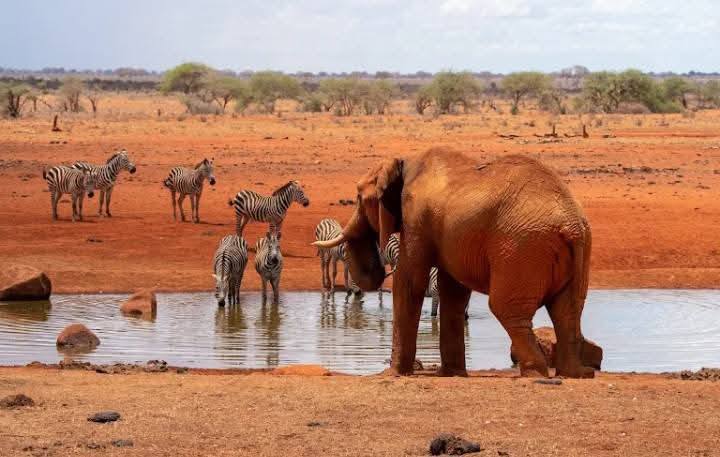

In the heart of Taita Taveta, the
ground trembles as herds of elephants, glowing a deep shade of rust-red from
dust baths, march slowly across the savannah.
This is Tsavo East, one of Kenya’s
oldest and largest national parks, a wild theatre where nature takes center
stage.
Spread over 13,700 square
kilometers, the park covers almost 40 percent of all national park land in
Kenya.
The Kenya Wildlife Service (KWS)
describes it as “a theatre of the wild,” a fitting name for a place
where life unfolds in its rawest form.
The park’s rugged beauty is framed
by dramatic landmarks.
The Yatta Plateau, the world’s
longest lava flow, stretches endlessly, while the Galana River winds through
semi-arid bushlands, feeding hippos, crocodiles and palm-lined oases that break
the monotony of the dry landscape.
But it is the elephants that define
Tsavo East. Bathing and rolling in the ochre-red soils, they create one of the
park’s most iconic images.
Along the Galana River, the giants
gather to spray, wallow and play, embodying the park’s reputation as “elephants
in Eden.”
KWS notes that Tsavo East is home to
some of the largest elephant herds in the country.
Yet they share the stage with other
big game; lions, leopards, rhinos, buffalo, hyenas and rare species such as the
hirola antelope and the long-necked gerenuk.
For bird lovers, the park is a
paradise boasting about 500 species, many of them migratory.
Visitors are often drawn not just by
the wildlife but also by Tsavo’s natural wonders.
Aruba Dam, located along the Voi
River, is a magnet for herds in the dry season and a favorite spot for game
viewing.
Mudanda Rock, a 1.5-kilometer
whale-back outcrop, towers above a waterhole where elephants congregate,
evoking comparisons to Australia’s Uluru — though on a smaller scale.
Then there are Lugard’s Falls, where
the Galana River squeezes through eroded rocks before plunging into foaming
rapids, feeding crocodile-infested pools below.
Formed of the Galana River’s passage over volcanic rock, Lugard falls is
situated south-east of Tsavo’s national parks.
The water’s passage through the unbending, volcanic rock has shaped it into
a series of flattened ledges.
The drop following has created a gorge that adds an echoing effect to the
cascading water.
It is a popular sight that can be reached by hiking trails and, as most
waterfalls do, the sight of it evokes thoughts of time’s passage and the
smallness of human lives.
The sound of rushing water echoes
through the park, a reminder that even in this semi-arid wilderness, nature
carves its own rhythms.
For tourists, Tsavo East offers more
than safari drives.
From camping and hiking to
birdwatching and photography, the park’s menu of activities appeals to
adventurers and families alike.
Its proximity to Voi town and the
Kenyan coast makes it one of the most accessible safari destinations for both
local and international visitors.
But Tsavo East is more than a
tourist gem.
To conservationists, it is a
biodiversity stronghold.
Protecting vast landscapes and species,
the park is central to the country’s efforts to safeguard its wildlife heritage
while supporting communities that rely on tourism.
As KWS puts it, Tsavo East remains “a
spectacular voyage of discovery.”
And for anyone who has stood at the
foot of Mudanda Rock watching elephants drink at sunset, or listened to the low
rumble of lions as night falls, it is easy to see why this park remains one of
the crown jewels of Kenya’s wild spaces.
If you are planning on visiting the park, remember to carry with you the
essentials including drinking water, picnic items and camping equipment if you
intend to stay overnight.
Also important are; camera, binoculars, sunscreen, insect repellant, first
aid kit, sunglasses and reserve car fuel if intending to be in the park longer,
clean drinking water, food, camping equipment if intending to camp.


















